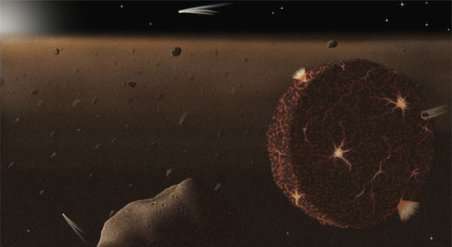How did the Late Heavy Bombardment affect Earth's crust?

Astrobiologists supported by the NASA Astrobiology Institute have assessed the effects of impacts on the crust of the early Earth. The research could help determine whether or not evidence of such violent events in our planet's early history could still be found in the geological record.
During the first billion years after its formation, the inner solar system was crowded with debris. This resulted in frequent collisions, which not only played a role in the formation and evolution of planets like Earth and Mars, but also helped shape their potential to host life. Today, it is difficult to determine the details of how this 'impact epoch' affected the young planets.
The new study estimates the thermal effects of a period known as the Late Heavy Bombardment (LHB) on Earth. The LHB is hypothesized to have occurred roughly 3.9 billion years ago during the Hadean eon, and was a time when impacts were especially frequent. Heat generated by the impacts left up to 10 percent of the planet's surface covered with melt sheets more than a kilometer thick. Ejecta and vaporized rock were sprayed into the air and deposited around the globe. Astrobiologists have long wondered if any evidence of LHB impacts could still remain in rocks left over from the Hadean (such as rocks from the Jack Hills in Australia).
To answer this question, the team of scientists focused on a mineral called zircon. Zircon contains lead, and this element can be removed from the mineral as it is melted and re-shaped by impacts.
The team used sophisticated models to determine whether or not zircons in Hadean rocks could contain signatures left over from the LHB based on the amount of lead they contain. They concluded that if these minerals indeed contain signatures of the LHB, they would have come from the impact ejecta (the materials tossed into the air by the violent collisions). Zircons in rocks at the surface of the planet would not likely have survived in the vast melt sheets.
The paper, "The impact environment of the Hadean Earth," was published in the journal Chemie der Erde – Geochemistry.
More information: Oleg Abramov, David A. Kring, Stephen J. Mojzsis, "The impact environment of the Hadean Earth," Chemie der Erde - Geochemistry, Volume 73, Issue 3, October 2013, Pages 227-248, ISSN 0009-2819, DOI: 10.1016/j.chemer.2013.08.004.
Provided by Astrobio.net





















